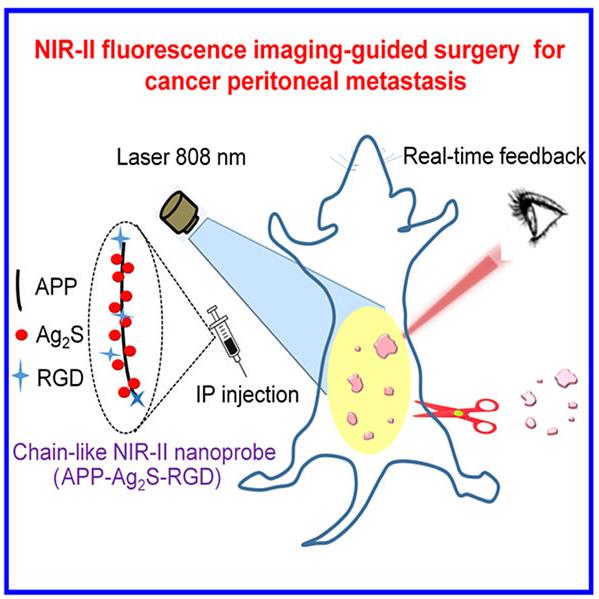Cytoreductive surgery is one of the most promising approaches for facile elimination of tumors in situ, thereby improving prognosis. However, it remains a challenge to achieve efficient cytoreduction owing to the poor visual contrast between cancer and normal tissues. Thus, it is of significance to develop and improve intraoperative visual methods for tumor therapy.
Recently, a research team led by Prof. WANG Qiangbin from Suzhou Institute of Nano-Tech and Nano-Bionics(SINANO), Chinese Academy of Sciences(CAS), developed a simple strategy to construct a novel chainlike NIR-II nanoprobe (APP-Ag2S-RGD) by self-assembly of an amphiphilic peptide (APP) into a nanochain with subsequent chemical crosslinking of NIR-II Ag2S QDs and the tumor-targeting RGD peptide (Schem1). This probe exhibits higher capability for cancer cell detection compared with that of RGD-functionalized Ag2S QDs (Ag2S-RGD) at the same concentration. Upon intraperitoneal injection, superior tumor-to-normal tissue signal ratio is achieved and non-vascularized tiny tumor metastatic foci as small as about 0.2 mm in diameter could be facilely eliminated under NIR-II fluorescent imaging guidance. These results clearly indicate the potential of this probe for fluorescence-guided tumor staging, preoperative diagnosis, and intraoperative navigation.

Scheme 1. Schematic illustration of the NIR-II fluorescent nanochain probe APP-Ag2S-RGD for image-guided peritoneal carcinomatosis surgery.(Image by SINANO)
This work entitled "NIR-II Fluorescent Self-Assembled Peptide Nanochain for Ultrasensitive Detection of Peritoneal Metastasis" was recently published in Angewandte Chemie International Edition. This work was financially supported by the National Key Research and Development Program of China, the National Natural Science Foundation of China and the Youth Innovation Promotion Association of Chinese Academy of Sciences.
Contact information: Prof. WANG Qiangbin,Suzhou Institute of Nano-Tech and Nano-Bionics, Chinese Academy of Sciences.
Email:qbwang2008@sinano.ac.cn
Reference: https://onlinelibrary_wiley.gg363.site/doi/abs/10.1002/ange.201905643.

